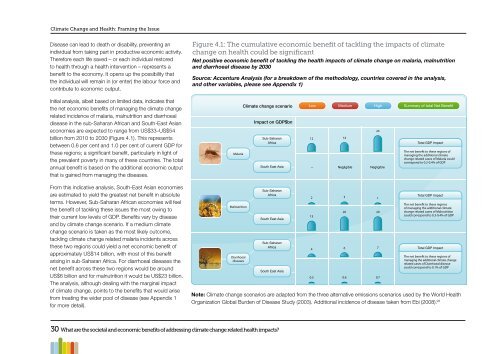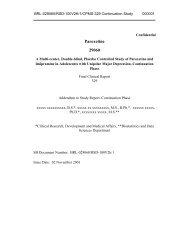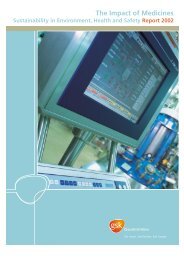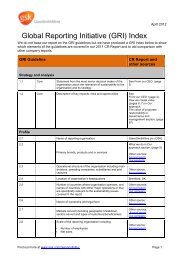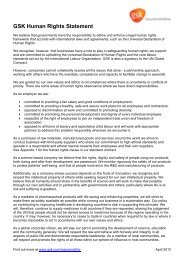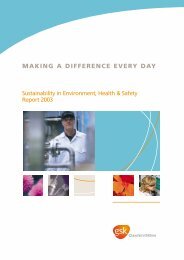Climate Change and Health: Framing the issue
Climate Change and Health: Framing the issue
Climate Change and Health: Framing the issue
Create successful ePaper yourself
Turn your PDF publications into a flip-book with our unique Google optimized e-Paper software.
<strong>Climate</strong> <strong>Change</strong> <strong>and</strong> <strong>Health</strong> <strong>Health</strong>: <strong>Framing</strong> Paper <strong>the</strong> Issue<br />
Disease can lead to death or disability, preventing an<br />
individual from taking part in productive economic activity.<br />
Therefore each life saved – or each individual restored<br />
to health through a health intervention – represents a<br />
benefit to <strong>the</strong> economy. It opens up <strong>the</strong> possibility that<br />
<strong>the</strong> individual will remain in (or enter) <strong>the</strong> labour force <strong>and</strong><br />
contribute to economic output.<br />
Initial analysis, albeit based on limited data, indicates that<br />
<strong>the</strong> net economic benefits of managing <strong>the</strong> climate change<br />
related incidence of malaria, malnutrition <strong>and</strong> diarrhoeal<br />
disease in <strong>the</strong> sub-Saharan African <strong>and</strong> South-East Asian<br />
economies are expected to range from US$33–US$54<br />
billion from 2010 to 2030 (Figure 4.1). This represents<br />
between 0.6 per cent <strong>and</strong> 1.0 per cent of current GDP for<br />
<strong>the</strong>se regions; a significant benefit, particularly in light of<br />
<strong>the</strong> prevalent poverty in many of <strong>the</strong>se countries. The total<br />
annual benefit is based on <strong>the</strong> additional economic output<br />
that is gained from managing <strong>the</strong> diseases.<br />
From this indicative analysis, South-East Asian economies<br />
are estimated to yield <strong>the</strong> greatest net benefit in absolute<br />
terms. However, Sub-Saharan African economies will feel<br />
<strong>the</strong> benefit of tackling <strong>the</strong>se <strong>issue</strong>s <strong>the</strong> most owing to<br />
<strong>the</strong>ir current low levels of GDP. Benefits vary by disease<br />
<strong>and</strong> by climate change scenario. If a medium climate<br />
change scenario is taken as <strong>the</strong> most likely outcome,<br />
tackling climate change related malaria incidents across<br />
<strong>the</strong>se two regions could yield a net economic benefit of<br />
approximately US$14 billion, with most of this benefit<br />
arising in sub-Saharan Africa. For diarrhoeal diseases <strong>the</strong><br />
net benefit across <strong>the</strong>se two regions would be around<br />
US$6 billion <strong>and</strong> for malnutrition it would be US$23 billion.<br />
The analysis, although dealing with <strong>the</strong> marginal impact<br />
of climate change, points to <strong>the</strong> benefits that would arise<br />
from treating <strong>the</strong> wider pool of disease (see Appendix 1<br />
for more detail).<br />
030Introduction<br />
30 What are <strong>the</strong> societal <strong>and</strong> economic benefits of addressing climate change related health impacts?<br />
Figure 4.1: The cumulative economic benefit of tackling <strong>the</strong> impacts of climate<br />
change on health could be significant<br />
Net positive economic benefit of tackling <strong>the</strong> health impacts of climate change on malaria, malnutrition<br />
<strong>and</strong> diarrhoeal disease by 2030<br />
Source: Accenture Analysis (for a breakdown of <strong>the</strong> methodology, countries covered in <strong>the</strong> analysis,<br />
<strong>and</strong> o<strong>the</strong>r variables, please see Appendix 1)<br />
Malaria<br />
Malnutrition<br />
Diarrhoeal<br />
diseases<br />
<strong>Climate</strong> change scenario<br />
Impact on GDP$bn<br />
Sub-Saharan<br />
Africa<br />
South East Asia<br />
Sub-Saharan<br />
Africa<br />
South East Asia<br />
Sub-Saharan<br />
Africa<br />
South East Asia<br />
Low Medium High<br />
12<br />
Summary of total Net Benefit<br />
Note: <strong>Climate</strong> change scenarios are adapted from <strong>the</strong> three alternative emissions scenarios used by <strong>the</strong> World <strong>Health</strong><br />
Organization Global Burden of Disease Study (2003). Additional incidence of disease taken from Ebi (2008). 98<br />
14<br />
– Negligible Negligible<br />
2 3 1<br />
15<br />
24<br />
20 20<br />
4 6 7<br />
0.5 0.6 0.7<br />
Total GDP Impact<br />
The net bene�t to <strong>the</strong>se regions of<br />
managing <strong>the</strong> additional climate<br />
change related cases of Malaria could<br />
correspond to 0.2-0.4% of GDP<br />
Total GDP Impact<br />
The net bene�t to <strong>the</strong>se regions<br />
of managing <strong>the</strong> additional climate<br />
change related cases of Malnutrition<br />
could correspond to 0.3-0.4% of GDP<br />
Total GDP Impact<br />
The net bene�t to <strong>the</strong>se regions of<br />
managing <strong>the</strong> additional climate change<br />
related cases of Diarrhoeal disease<br />
could correspond to 0.1% of GDP


